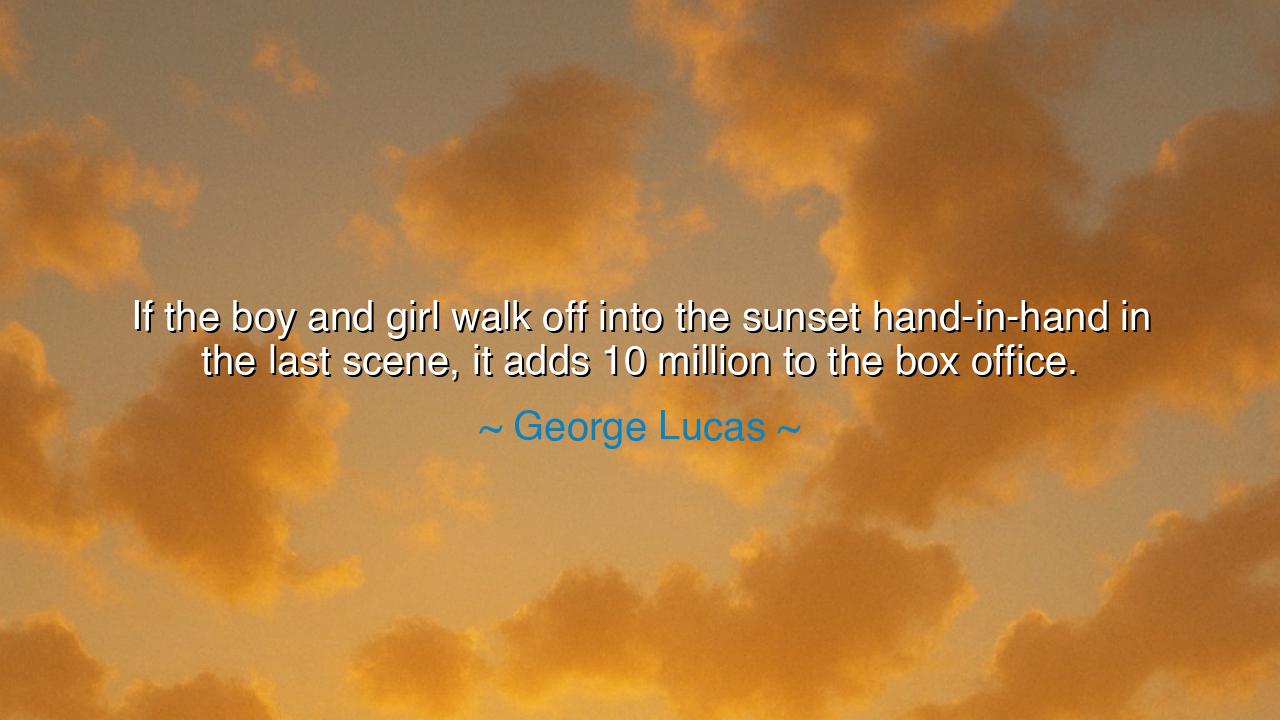
If the boy and girl walk off into the sunset hand-in-hand in the
If the boy and girl walk off into the sunset hand-in-hand in the last scene, it adds 10 million to the box office.






Hear the knowing words of George Lucas, architect of galaxies far, far away, who once declared: “If the boy and girl walk off into the sunset hand-in-hand in the last scene, it adds 10 million to the box office.” Though spoken with the wit of a storyteller who understood the commerce of cinema, the saying carries within it a truth both ancient and enduring: that human hearts are ever drawn to endings of hope, of unity, of love fulfilled. The marketplace may count such things in coin, but beneath the surface lies something far older than profit—the timeless longing for resolution and harmony.
The meaning of Lucas’s words lies in the eternal pull of the happy ending. For millennia, tales have closed with lovers united, with journeys ending in peace, with the sun descending upon a horizon of promise. This is not mere convention, but a reflection of the human soul’s hunger for completion. The audience, who has endured trial, fear, and danger alongside the characters, longs for release, longs for assurance that love endures and life continues. To deny this entirely is to leave the heart restless; to grant it is to send the spirit home satisfied.
The origin of this wisdom reaches back to the myths of old. Consider the story of Odysseus, who after trials upon the sea, at last returns to Ithaca and to his faithful Penelope. The tale does not end with him adrift, nor with Penelope alone, but with their reunion. The Greeks, like us, craved not only the adventure but the return, the joining of love after strife. This was their “walking into the sunset,” and it gave their listeners the balm of wholeness. Lucas’s words remind us that cinema inherits this same tradition: people are not only entertained, they are healed by the promise that suffering gives way to joy.
The history of cinema itself proves this. When Casablanca first appeared, it dared to deny the lovers their sunset; Rick and Ilsa part for duty’s sake. Yet even then, audiences carried away a bittersweet sense of nobility and sacrifice—a different kind of completeness. Contrast this with the sweeping finales of countless romances, from Gone with the Wind to Titanic, where the image of love fulfilled or tragically interrupted lingers as the central heartbeat of the story. Such endings carry great power, for they address not only the mind but the deepest emotional currents of humanity.
Lucas, the creator of Star Wars, knew this instinctively. Though his stories were clad in the trappings of space battles and galactic empires, they rested upon human truths: the pull of friendship, the triumph of hope, the yearning for love. He knew that beyond special effects and spectacle, what fills theaters and endures in memory are moments where characters grasp one another’s hands, stand together, and face the future not alone but united. Hence his jest: that a couple walking into the sunset might be worth millions—not only in gold, but in the loyalty of hearts.
The lesson here is profound. In life as in art, people crave not merely action, not merely conflict, but resolution, reconciliation, and love. To offer hope is not weakness—it is nourishment. When we conclude our own chapters, whether in words, in deeds, or in farewells, let us strive to leave behind a sense of wholeness. Let our actions close not in bitterness, but in gestures that unite, encourage, and inspire.
So, children of tomorrow, engrave this wisdom upon your hearts: endings matter. Whether in film, in friendship, or in life itself, seek to bring closure that uplifts, that affirms, that binds. For though Lucas spoke in jest of the box office, he revealed an eternal truth: the heart treasures most those stories that end with hope, with love, and with the light of a sunset promising a brighter dawn.






AAdministratorAdministrator
Welcome, honored guests. Please leave a comment, we will respond soon